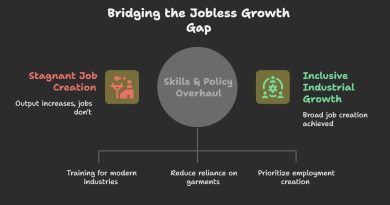In my book “Bangladesh Stabilizing the Macroeconomy” published in December 2023, I had argued that the Bangladesh macroeconomic imbalances have emerged from three sources: inflationary pressure, balance of payments pressure and fiscal pressure.
Addressing these imbalances requires the use of three well-coordinated policy instruments. Monetary policy primarily focused on inflation control, exchange rate policy to stabilise the balance of payments, and fiscal policy to reduce the fiscal pressure. The coordinated use of these three policy instruments is necessary in order to avoid internal policy inconsistencies.
I had further elaborated the nature of the policy adjustments in each of these three areas. Regarding monetary policy, the main focus should be to deregulate the interest rate so that monetary tightening required to reduce inflation is transmitted through a market based interest rate policy.
Concerning exchange rate, the challenge is to adopt a fully flexible exchange rate such that the prevailing rate is determined by market forces. The fiscal policy objective is to lower the fiscal deficit without decreasing public spending that supports growth or reduces poverty.
This requires a strong public resource mobilisation effort based on tax and public enterprise reforms and expenditure re-prioritisation where populist-type spending such as general purpose subsidies is cut while spending on energy, transport, water, health, education and social protection is increased.
How has the macroeconomic stabilisation agenda progressed over the past 19 months since I authored the book?
Starting in May 2024, the macroeconomic reforms have made substantial progress. The interest rate has been deregulated and is now market based. Bangladesh Bank (BB) influences the interest rate through its policy rate and quantitative targets for money supply.
The exchange rate has also been liberalised with limited intervention by BB. Presently, the exchange rate is largely market based, although there is scope for further liberalisation of the current account.
Some progress has also been made in lowering the fiscal deficit and in particular in reducing bank borrowings for financing the fiscal deficit. The overall fiscal deficit and the primary deficit both show a downward trend. However, these reductions have resulted from sharp cutbacks in public spending, especially development spending, raising concerns about the quality and sustainability of the fiscal adjustment.
What is the impact of these policy reforms on macroeconomic outcomes? As far as macroeconomic imbalances are concerned, there has been solid progress. The balance of payments deficit has been sharply reduced.
Exchange rate flexibility has boosted exports and remittances, as predicted. Reserves have stabilised and there has been some increase in recent months. On the inflation front, some visible signs of progress have also emerged. The inflation rate, which had been rising, is now gradually decreasing. Reductions in fiscal deficit and bank borrowing to finance the deficit are reinforcing the demand management efforts.
While this progress with lowering the macroeconomic imbalances should be celebrated, the reform agenda has fallen flat in the area of economic growth. GDP growth plunged to below 4% in FY2025. Indeed, a part of the macroeconomic adjustment has come from lower GDP growth that has suppressed the demand for imports and private sector credit. This is not a desirable outcome.
There is no necessary trade-off between the growth and the stabilisation agendas. The downward trend in GDP growth is the culmination of several factors, of which a major component is the weakness of the fiscal policy.
While the reductions in the fiscal deficit and bank borrowing for deficit financing have supported the fall in inflation and the balance of payments deficit, as noted these reductions have been brought about primarily by cutbacks in essential spending on infrastructure, health, education and social protection, which have hurt growth and poverty reduction.
The revenue mobilisation effort has basically failed. The tax to GDP ratio declined further in FY2025 from its already low level, falling to 7.3% of GDP. This is amongst the lowest tax efforts in recent years.
Similarly, no progress was made in improving the financial performance of the state owned enterprises (SOEs) that continued to show negative profitability on aggregate. Most SOEs are basically struggling with life support from Treasury transfers. Expenditure cutbacks to contain fiscal deficit caused total expenditure to fall below 12% of GDP, which is also among the lowest public spending in recent years.
What is especially worrisome is the sharp cutback in ADP spending, falling below 3% of GDP. While there is adequate scope for efficiency improvements in ADP allocations and project selection, this level of ADP spending is not consistent with growth enhancing or poverty reduction strategies over the longer term.
In addition to the fiscal constraint, the GDP recovery process suffered owing to the lack of progress on reforms of the investment climate, trade policy, growing energy constraints, and the skills gap.
The adverse effects of these economic factors have been intensified by political instability and a seriously weak law and order situation. Domestic private investment is sluggish, foreign direct investment has not shown any signs of recovery, while public investment has fallen owing to sharp cutbacks in ADP spending.
The limited stimulus for growth from rising exports and remittances was muted by these adverse growth determinants.
Looking forward, it is highly unlikely that the investment climate will improve much until the political uncertainties are lifted and the law and order situation improves through a credible and inclusive national election.
Trade, energy, transport, skills, and other growth drivers are unlikely to improve significantly until a newly elected national government is in place, critical reforms related to these growth drivers are debated in the parliament and then implemented.
Sadiq Ahmed is Vice Chairman of the Policy Research Institute of Bangladesh.






